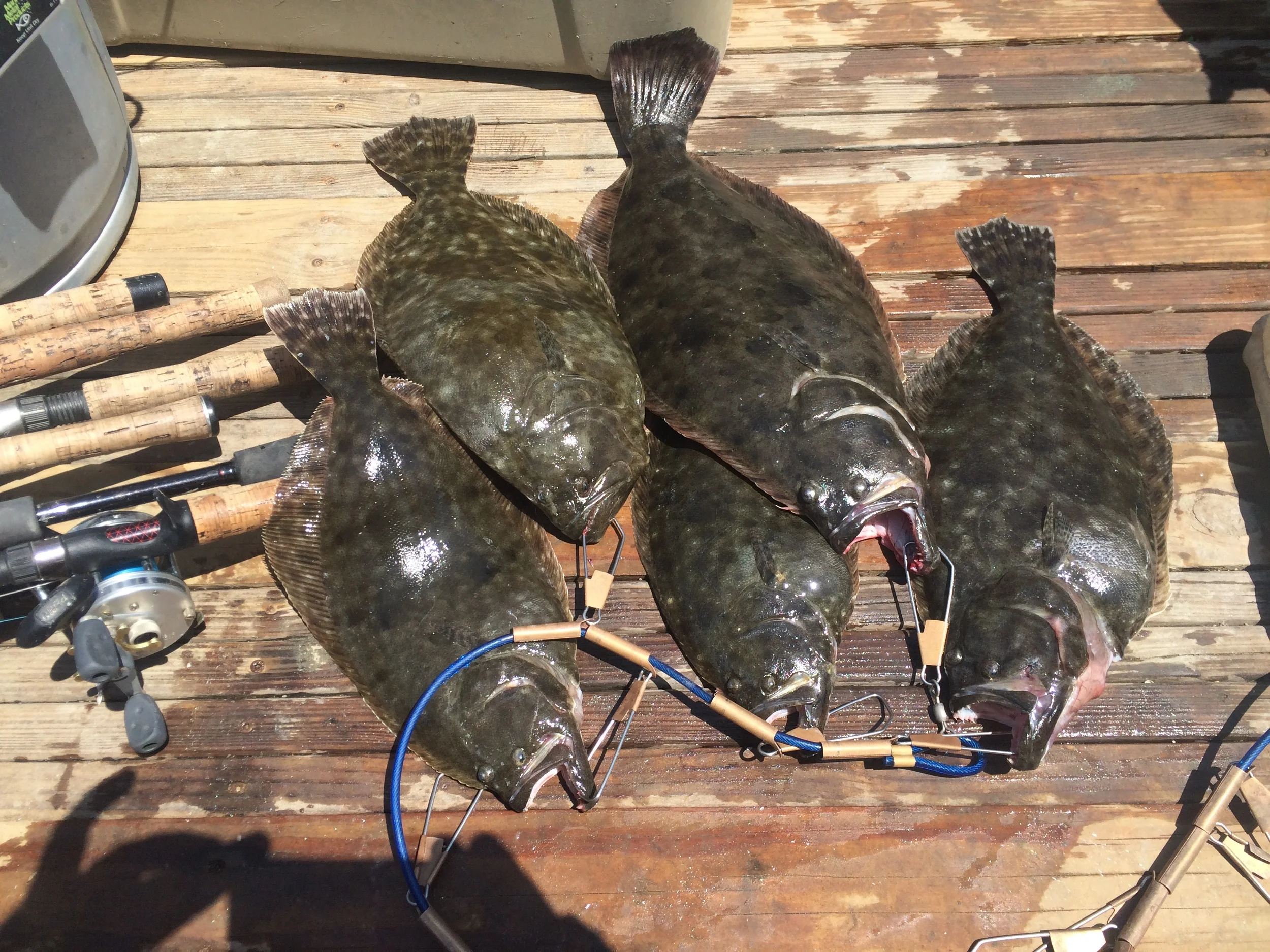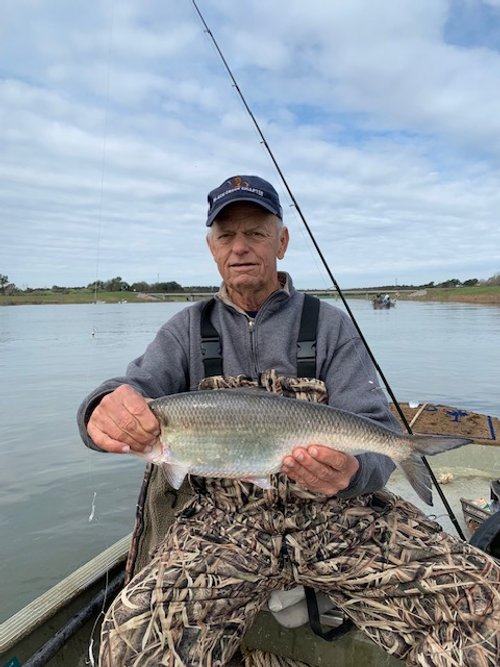Fishing Species
These are some of the most popular saltwater species we fish. Availability varies by year and season. We also charter freshwater fishing trips for catfish, striper, panfish, bluegill and others.
Let us know if you're interested in specific fish and we can pick a time and location to ensure a fun, successful trip.
Black Drum
The black drum is a saltwater fish similar to its cousin, the red drum. Though most specimens are generally found in the 5-30 lb (2–14 kg) range, the black drum is well known as the largest of all the drum family with some specimens reaching excesses of 90 lb (40 kg). The world record black drum was just over 113 lb (51 kg).
Black drum are often black and/or gray in color with juvenile fish having distinctive dark stripes over a gray body. Their teeth are rounded and they have powerful jaws capable of crushing oysters and other shellfish. It is recommended those over 15 lb pounds (7 kg) should be released.
An illustration of the black drum from dnr.sc.gov
From the Gulf, a smaller black drum with faint vertical stripes.
Flounder
Also known as: Fluke, Doormat
We usually fish southern flounder but also occasionally see its cousins the summer and gulf flounders. The southern flounder is a species of large-tooth flounders native to our coast. An always-popular fish, it is and is the largest and most commercially valuable flounder in this part of the Atlantic; it ranges all the way from North Carolina down to the Yucatan Peninsula.
The southern flounder is a "left-eyed flounder", meaning the left side is pigmented and is the "up side". The body color is generally brown with diffuse spots and blotches.
12 – 14 inches, 1 – 2 pounds;
SC State Record: 17 pounds, 6 ounces (1974);
Max age: males, 5 years; females, 7-8 years; females are generally larger and outlive males.
An illustration of the flouder from dnr.sc.gov
Southern flounder from a trip in May, 2015.
Red Drum
Also known as: RedFish, spottail bass, reds, puppy drum
Iridescent silver-gray with a copper cast, darker above; one or more oscillated spots on upper sides from below soft portion of dorsal fin to base of caudal fin. Mouth inferior and horizontal, teeth set in bands on both jaws. Chin without barbels, smooth pre-opercular margin.
18 inches, 2.6 pounds
SC Record: 75 pounds (1965)
Max age: 38 years (a few individuals as old as 60 have been reported in other states).
Illustration of a red drum from dnr.sc.gov
A red drum from one of our trips in April, 2015
Spotted Seatrout
Also known as: Speckled Trout, Winter trout
Dark gray above with bluish reflections. Numerous round black spots irregularly scattered on back and sides, extend to soft parts of dorsal and caudal fins. Two large canine-like teeth at tip of upper jaw, all remaining teeth small, gradually increasing in size posteriorly on lower jaw. First dorsal fin with 9 – 10 spines, second dorsal fin with one spine and 25 – 28 rays. Soft portion of dorsal fin without scales.
14 inches, 1.3 pounds
SC State Record: 11 pounds, 13 ounces (1976)
Max age: 8 – 10 years.
An illustration of a spotted seatrout from dnr.sc.gov.
A spotted seatrout we caught in September, 2015.
Summer Trout
Also known as: Weakfish
The summer trout, Cynoscion regalis, is in the drum family Sciaenidae.
Weakfish are also known by the American Indian name Squeteague. In the mid-Atlantic states, the fish is sometimes referred to by the name sea trout, though it is not related to the fishes properly called trout, which are in the family Salmonidae.
A medium-large, slender, marine fish, it is found along the east coast. The head and back of this fish are dark brown in color with a greenish tinge. The sides have a faint silvery hue with dusky specks; the belly is white. The origin of its name is based on the weakness of the mouth muscles, which often cause a hook to tear free, allowing the fish to escape.
13 inches, 1 pound;
SC Record: 11 pounds, 13 ounces (1981)
Max age: 12 years
llustration of a summer trout from dnr.sc.gov
Sheepshead
Also known as: Convicts
Body gray and nearly oval with 5 – 6 dark vertical bars and one on nape. No dark spot near origin of lateral line. Four broad incisor-like teeth on both sides of anterior jaw, several molar-like teeth also present. Dorsal fin has 12 spines and 11 soft rays. Second spine of anal fin very strong.
14 inches, 3 pounds
SC Record: 16 pounds, 6 ounces (2008)
Max age: 25 years.
Illustration of a sheepshead from dnr.sc.gov
A sheepshead caught by a frequent guest in March 2016.
Tarpon
Also known as: Silver King
Silvery, scales large, eyes large; lower jaw projects forward of fish. Dorsal fin originates near mid-point of body; last ray on dorsal fin filamentous and very long.
40 – 60 inches, 40 – 60 pounds
SC Record: 154 pounds 10 ounces (1987)
Max age: 50 years – possibly up to 70 years.
Illustration of a tarpon from dnr.sc.gov.
An Atlantic tarpon underwater.
Shark
Species include Spinner, Black Tip, Bonnethead, Bull, Sharpnose
The Atlantic sharpnose shark is a small shark in comparison to others. The Atlantic sharpnose shark's maximum species length is known to be about 110–120 cm (3.6–3.9 ft). Although its average adult size tends to be about 91.4–99 cm (3.00–3.25 ft). Reports exist of these sharks living up to 12 years in the wild. A distinctive feature is that juveniles have black edges on the dorsal and caudal fins.
The spinner shark is a species of requiem shark named for the spinning leaps it makes as a part of its feeding strategy. This species occurs in tropical and warm temperate waters worldwide, except for in the eastern Pacific Ocean. It is found from coastal to offshore habitats to a depth of 100 m (330 ft), though it prefers shallow water. The spinner shark resembles a larger version of the blacktip shark with a slender body, long snout, and black-marked fins. This species can be distinguished from the blacktip shark by the first dorsal fin, which has a different shape and is placed further back, and by the black tip on the anal fin (in adults only). It attains a maximum length of 3 m (9.8 ft).
Atlantic sharpnose shark.
Spinner shark.
A bonnethead shark caught and released in August, 2014.
Check out this shark identification guide from the NOAA.
Shad
The American shad’s body is blue or green in color along the top of its body with silvery sides. At the upper side of the gill flap, a dark spot is present which is usually followed by a row of smaller spots along the upper side of the body.
Shad live in fresh or brackish water along the coastal plain and migrate into inland rivers to spawn between January and April.
Avg. size: 24 inches, 4 pounds
SC Record: 7 pounds (1985)
Life expectancy: 5 years
Illustration of an American Shad from dnr.sc.gov

